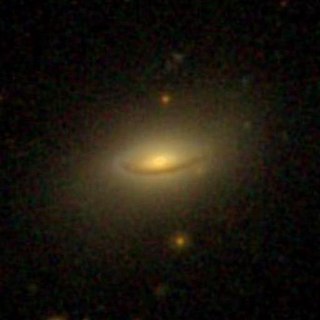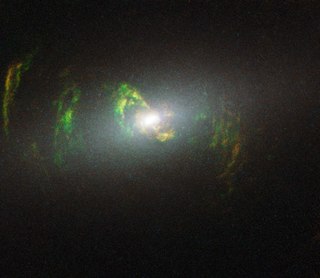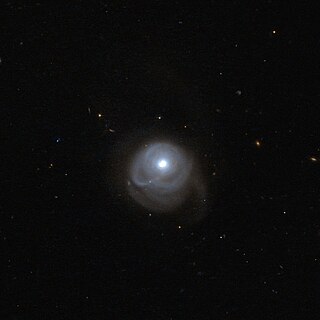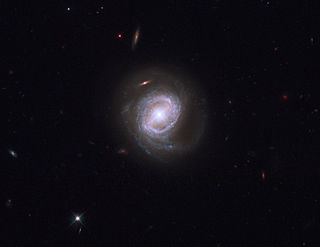An active galactic nucleus (AGN) is a compact region at the center of a galaxy that emits a significant amount of energy across the electromagnetic spectrum, with characteristics indicating that this luminosity is not produced by the stars. Such excess, non-stellar emissions have been observed in the radio, microwave, infrared, optical, ultra-violet, X-ray and gamma ray wavebands. A galaxy hosting an AGN is called an active galaxy. The non-stellar radiation from an AGN is theorized to result from the accretion of matter by a supermassive black hole at the center of its host galaxy.

Seyfert galaxies are one of the two largest groups of active galaxies, along with quasar host galaxies. They have quasar-like nuclei with very high surface brightnesses whose spectra reveal strong, high-ionisation emission lines, but unlike quasars, their host galaxies are clearly detectable.

The Black Eye Galaxy is a relatively isolated spiral galaxy 17 million light-years away in the mildly northern constellation of Coma Berenices. It was discovered by Edward Pigott in March 1779, and independently by Johann Elert Bode in April of the same year, as well as by Charles Messier the next year. A dark band of absorbing dust partially in front of its bright nucleus gave rise to its nicknames of the "Black Eye", "Evil Eye", or "Sleeping Beauty" galaxy. M64 is well known among amateur astronomers due to its form in small telescopes and visibility across inhabited latitudes.

NGC 4395 is a nearby low surface brightness spiral galaxy located about 14 million light-years from Earth in the constellation Canes Venatici. The nucleus of NGC 4395 is active and the galaxy is classified as a Seyfert Type I known for its very low-mass supermassive black hole.

NGC 708 is an elliptical galaxy located 240 million light-years away in the constellation Andromeda and was discovered by astronomer William Herschel on September 21, 1786. It is classified as a cD galaxy and is the brightest member of Abell 262. NGC 708 is a weak FR I radio galaxy and is also classified as a type 2 Seyfert galaxy.

NGC 5846 is an elliptical galaxy located in the constellation Virgo. It is located at a distance of circa 90 million light years from Earth, which, given its apparent dimensions, means that NGC 5846 is about 110,000 light years across. It was discovered by William Herschel on February 24, 1786. It lies near 110 Virginis and is part of the Herschel 400 Catalogue. It is a member of the NGC 5846 Group of galaxies, itself one of the Virgo III Groups strung out to the east of the Virgo Supercluster of galaxies.

NGC 1386 is a spiral galaxy located in the constellation Eridanus. It is located at a distance of circa 53 million light years from Earth, which, given its apparent dimensions, means that NGC 1386 is about 50,000 light years across. It is a Seyfert galaxy, the only one in Fornax Cluster.

NGC 4074 is a peculiar lenticular galaxy located 310 million light-years away in the constellation Coma Berenices. It was discovered by astronomer William Herschel on April 27, 1785 and is a member of the NGC 4065 Group.

NGC 5252 is a lenticular galaxy located in the constellation Virgo. It is located at a distance of about 220 to 320 million light years from Earth, which, given its apparent dimensions, means that NGC 5252 is about 100,000 light years across. It was discovered by William Herschel on February 2, 1786.

IRAS 05189-2524 is a galaxy merger located in the constellation Lepus. It is located 603 million light-years away from the Solar System and has an approximate diameter of 75,000 light-years.

Markarian 817 is a barred spiral galaxy located in the constellation Draco. It is located 456 million light-years from Earth, which, given its apparent dimensions, means that Markarian 817 is about 80,000 light-years across. It is a Seyfert galaxy.

IRAS F11119+3257 or simply as F11119+3257, is a galaxy located in constellation Ursa Major. With a redshift of 0.187580, it has a light travel time distance of 2.5 billion light-years and is considered an ultraluminous infrared galaxy (ULIRG).

SDSS J0849+1114 is a late-stage galaxy merger forming from a trio of galaxies located in the constellation of Cancer. At the redshift of 0.077, they are located 1.06 billion light-years from Earth. First discovered as a triple active galactic nucleus (AGN) candidate in a Sloan Digital Sky Survey study published in 2011, they received significant attention when astronomers discovered it harbors three supermassive black holes in its center.

SDSS J135646.10+102609.0 known as SDSS J1356+1026 and J1356+1026, is a low redshift quasar and galaxy merger located in the constellation of Boötes. It is located 1.85 billion light years from Earth. It is an ultraluminous inflared galaxy. It is considered radio-quiet with an unresolved radio source.

Markarian 463 known as UGC 8850, is a galaxy merger located in the constellation Boötes. It is located 706 million light years from Earth. It is classified a double nucleus Seyfert galaxy.

IC 485 is a spiral galaxy located in the constellation of Gemini, located 375 million light years from Earth. It was discovered by the Austrian astronomer, Rudolf Spitaler on March 6, 1891. It has an estimated diameter of 1.35' x 0.32' arcmin, meaning the galaxy is about 135,000 light years across.

IRAS 10565+2448 known as IRAS F10565+2448, is a galaxy merger located in the constellation of Leo. It is located at a distance of 625 million light years from Earth. It is classified as an ultraluminous infrared galaxy with an infrared luminosity of 1.2 x 1012 LΘ. It has a star formation rate of 131.8 MΘ yr−1.

Markarian 1014 known as PG 0157+001 is a quasar located in the constellation Cetus. It is located at a distance of 2.47 billion light years from Earth and is classified as a Seyfert galaxy as well as an ultraluminous infrared galaxy (ULIRG).

MCG +08-11-011 known as UGC 3374, is a galaxy located in the constellation of Auriga. It is located 401 million light years from Earth and is classified as a Seyfert galaxy.

1H 0323+342 known as 2MASX J032441.19+341045.9, is a galaxy located in the constellation of Perseus. It is located 831 million light years from Earth. It is classified a gamma-ray emitting narrow-line Seyfert galaxy, the nearest known example of this subtype.



















